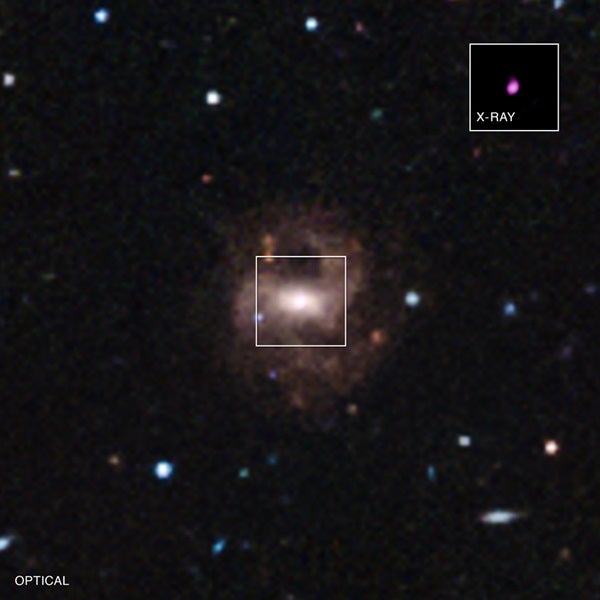Astronomers estimate this supermassive black hole is about 50,000 times the mass of the Sun. This is less than half the mass of the previous smallest black hole at the center of a galaxy.
“It might sound contradictory, but finding such a small, large black hole is very important,” said Vivienne Baldassare of the University of Michigan in Ann Arbor. “We can use observations of the lightest supermassive black holes to better understand how black holes of different sizes grow.”
The tiny heavyweight black hole is in the center of a dwarf disk galaxy, called RGG 118, located about 340 million light-years from Earth, and was originally discovered using the Sloan Digital Sky Survey.
Researchers estimated the mass of the black hole by studying the motion of cool gas near the center of the galaxy using visible-light data from the Clay Telescope. They used the Chandra data to figure out the X-ray brightness of hot gas swirling toward the black hole. They found the outward push of radiation pressure of this hot gas is about 1 percent of the black hole’s inward pull of gravity, matching the properties of other supermassive black holes.
Previously, scientists had noted a relationship between the mass of supermassive black holes and the range of velocities of stars in the centers of their host galaxies. This relationship also holds for RGG 118 and its black hole.
“We found this little supermassive black hole behaves very much like its bigger, and in some cases much bigger, cousins,” said Amy Reines of the University of Michigan. “This tells us black holes grow in a similar way no matter what their size.”
The black hole in RGG 118 is nearly 100 times less massive than the supermassive black hole found in the center of the Milky Way. It’s also about 200,000 times less massive than the heaviest black holes found in the centers of other galaxies.
Astronomers are trying to understand the formation of billion-solar-mass black holes from less than a billion years after the Big Bang, but many are undetectable with current technology. The black hole in RGG 118 gives astronomers an opportunity to study a nearby small supermassive black hole.
Astronomers think supermassive black holes may form when a large cloud of gas, with a mass of about 10,000 to 100,000 times that of the Sun, collapses into a black hole. Many of these black hole seeds then merge to form much larger supermassive black holes. Alternately, a supermassive black hole seed could come from a giant star, about 100 times the Sun’s mass, that ultimately forms into a black hole after it runs out of fuel and collapses.
“We have two main ideas for how these supermassive black holes are born,” said Elena Gallo of the University of Michigan. “This black hole in RGG 118 is serving as a proxy for those in the very early universe and ultimately may help us decide which of the two is right.”
Researchers will continue to look for other supermassive black holes that are comparable in size or even smaller than the one in RGG 118 to help decide which of the models is more accurate and refine their understanding of how these objects grow.










